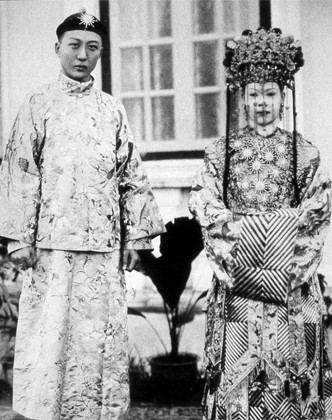Features on Asian Art, Culture, History & Travel
Archives
Archives > THAILAND > Chinese In Thailand

Chinese In Thailand
SEE RELATED IMAGES @ PICTURES FROM HISTORY
Thailand enjoys the unique and fortunate distinction of being the only nation in Southeast Asia to have chosen - more or less - to get along peaceably with its considerable ethnic Chinese population.
This is not to deny that tensions have sometimes arisen, but the fact remains that Thailand alone has chosen to live with and attempt to assimilate the Chinese in its midst, rather than "culling" them through periodic massacre (as in Burma, Malaysia, Indonesia and even, in times long past, the Philippines); driving them out through economic and social discrimination (in Vietnam); or most recently and horrifically through simple genocide (in Khmer Rouge Cambodia).
In regional terms, only in Singapore do Chinese people enjoy fuller rights to celebrate their ethnic and cultural heritage; but then, of course, Singapore has effectively become a Chinese state - the very development that massacre, expulsion and assimilation have been employed, elsewhere in the region, to avoid.
Ethnic Chinese have been migrating to Thailand for a long time. Indeed, according to most historians, the Chinese people - who call themselves Han - have been moving south from their original homelands by the Huang, or Yellow River, for several millennia. Of course, being a vigorous and numerous people they have been moving in other directions, too! But Thailand is part of Nan Yang, or the "Southern Ocean" - the traditional Chinese term for Southeast Asia, so looked at from Bangkok, it is the southern expansion of the Chinese people which really matters.
Leaving aside, for the sake of brevity, the contentious issue of Nan Chao and the supposed southern expansion of the Tai people - pushed, it is sometimes argued, by the expanding Han - by about 1250 the first Tai kingdom in Siam had been established at Sukhothai. Even at this early date it seems certain that cultural and commercial links existed with China, and that Chinese people were travelling to Hsien Lo - as Siam appears in the Chinese annals - on a regular basis.
These early traders, mendicants, travellers and diplomats came by land and by sea, and once in Siam seem to have been treated with considerable tolerance. Even at this early date, intermarriage between Tai and Chinese seems to have been common, and cultural assimilation (between what are, after all, two closely related peoples) preferred to massacre as a means of control.
By the 19th century, with the introduction of cheap steamship travel and declining conditions in China itself, the steady trickle of Chinese migrants became a flood. Chinese coolies (from the Chinese ku-li, or "bitter labour") sought new lives and a higher standard of living throughout Southeast Asia and beyond - even in distant California, Southern Africa and South America. It is from this time that the term "Overseas Chinese" becomes common, though in the case of Thailand, Burma, Laos and Vietnam it is misleading. Here there are many "Overland Chinese" as well.
As a result of this great influx of Han migrants, Bangkok - like Ho Chi Minh City, Yangon, Jakarta and of course Singapore - became increasingly Chinese cities. During the 19th century the best estimates indicate that the Chinese minority in Thailand grew from about 200,000 to nearly 800,000 or from less than 5% to almost 10% of the total. The contribution which these Chinese migrants made to the development of modern Thailand was tremendous. In a society where ambitious young Siamese might set their sights on a career in the bureaucracy or on becoming Buddhist monks, the Han were unashamedly and wholeheartedly devoted to commerce. In consequence, the Chinese acted as the driving force in building the modern sector of Thailand's economy - and of course they became very rich and influential in so doing.
Inevitably, there was a price to pay for this economic success. Elsewhere in the region that price was often expropriation, sometimes even expulsion or death. But not, thankfully, in Thailand. Here the price was assimilation - the taking of a Thai name, the sending of Chinese children to Thai schools, intermarriage with the host population and political loyalty to the Thai polity. This policy - at its harshest under Pibul Songkhram, but applied in a paternalistic manner until modern times - has resulted in the permanent presence of a Chinese element in Thai society. Indeed, so mixed have the Tai and the Han become, that distinctions have often blurred.
Today, relatively few look-chin, as the children of Chinese migrants are colloquially known, can read Chinese - though many can still speak Chinese regional dialects. Yet every Thai knows which of their neighbours is or isn't look-chin, and many - very many - Thais, from Chiang Mai to Hat Yai, claim part-Chinese ancestry with every indication of pride. By any standards, this is a considerable human achievement - especially when the "killing fields" of Cambodia, or the ethnic hostility directed against Chinese elsewhere in the region, are taken into account.
SEE MORE CHINESE IN THAILAND IMAGES @ PICTURES FROM HISTORY
Photos by Pictures From History - © CPA Media
